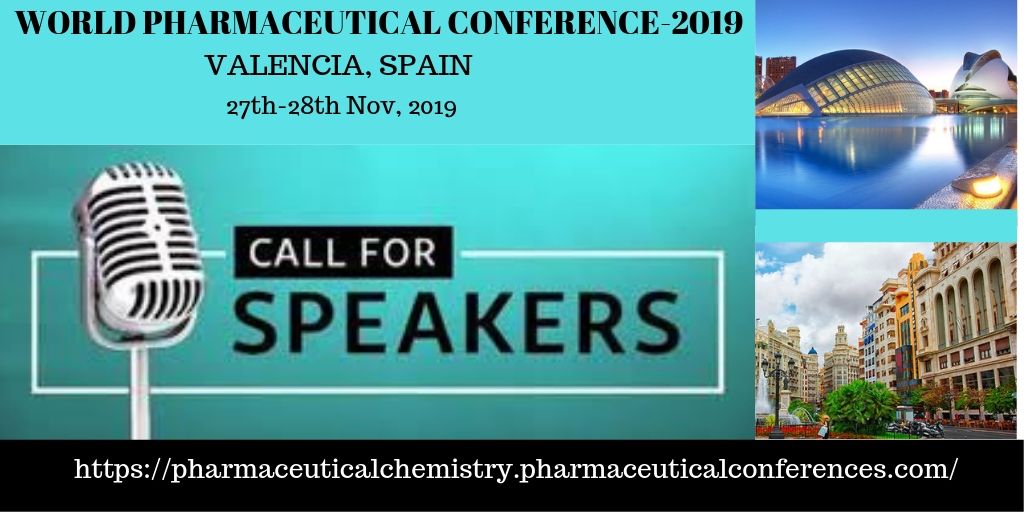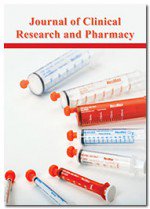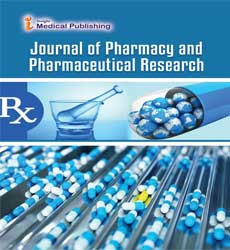Theme: Advancement in Pharmaceutical Sciences
Pharmaceutical Conference-2019
Pharmaceutical Chemistry and Clinical Research is a global overview the Theme: “Advancement in Pharmaceutical Sciences”. It is a pavement for Pharmaceutical and Chemistry experts and scientific professionals to explore the research challenges & current trends and unleash advanced strategies in the arena of Pharma and Chemistry research areas. Pharmaceutical Conference 2019 is a specially designed cluster conference and would lay a platform for the interaction among specialists, directors, professors, faculties, experts and research fellows around the world reputed research institutes, universities and companies, agencies, association & societies. It aims in accelerating the scientific discoveries in the field of Pharma and Chemistry to exchange information on their latest research progress. We are glad to have your presence at ‘World Conference on Pharmaceutical Chemistry and Clinical Research’ scheduled to be held during 27th-28th November, 2019 Valencia, Spain. The organizing committee is gearing up for an exciting and informative event procuring plenary lectures, symposium, workshops on a variety of topics, poster presentations and various sessions for participants from all over the world. All the members of Pharmaceutical Conference-2019 organizing committee look forward to meet you at Valencia, Spain.
For more details please visit- https://pharmaceuticalchemistry.pharmaceuticalconferences.com/
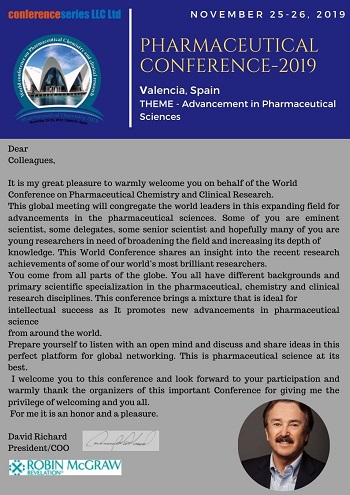
Track 1: Pharmaceutics & Biopharmaceutics
Pharmaceutics is the discipline of pharmacy that manages the way toward turning a new chemical entity (NCE) or old drugs into a medicine to be utilized securely and adequately by patients. Pharmaceutics relates the definition of drugs to their conveyance and demeanor in the body. Pharmaceutics deals with the formulation of a pure drug substance into a dosage form. Branches of pharmaceutics incorporate:- Pharmaceutical formulation, Pharmaceutical manufacturing, Dispensing pharmacy, Pharmaceutical technology, Physical pharmacy, Pharmaceutical jurisprudence.
Biopharmaceutics looks at the interrelationship of the physical/chemical properties of the drug, the dosage form (drug product) in which the drug is given, and the route of administration on the rate and extent of systemic drug absorption.
Related Societies :
Societies in USA: International Biopharmaceutical Association, Consumer Healthcare Products Association (CHPA), Generic Pharmaceutical Association (GPhA), International Pharmaceutical Expedient Council, Pharmaceutical Research and Manufacturers of America (PhRMA) Synthetic Organic Chemical Manufacturers Association (SOCMA), Biotech Industry Association (BIO), Parenteral Drug Association (PDA), Chinese Biopharmaceutical Association, Pharma & Biopharma Outsourcing Association (PBOA), SAFE-BioPharma Association and The BioPharmaceutical Emerging Best Practices Association (BEBPA)
Societies in Europe: European Federation of Pharmaceutical Industries and Associations (EFPIA), European Biopharmaceutical Enterprises (EBE), European Association of Pharma Biotechnology, International Federation of Pharmaceutical Manufacturers & Associations, European Federation of Biotechnology, EuropaBio and European and Developing Countries Clinical Trials Partnership.
Societies in Asia: The Hong Kong Association of the Pharmaceutical Industry, International Pharmaceutical Manufacturers Group, International Research-based Pharmaceutical Manufacturers Association, Japan Pharmaceutical Manufacturers Association, Korea Pharmaceutical and Bio-Pharma Manufacturers Association, Korean Research-based Pharmaceutical Industry Association, Organization of Pharmaceutical Producers of India, Pharmaceutical Association of Malaysia, Pharmaceutical and Healthcare Association of the Philippines, China Pharmaceutical Innovation & Research Development Association, Pharmaceutical Research & Manufacturers Association, R&D-based Pharmaceutical Association Committee, Singapore Association of Pharmaceutical Industries.
Track 2: Medicinal Chemistry
Therapeutic or medicinal Chemistry is the exploration of structure and chemical synthesis concentrating primarily on small organic molecules and their advancement of pharmaceutical specialists, or bio-dynamic molecules (drugs). It is an invigorating field as it joins numerous scientific disciplines and takes into account coordinated effort with different researchers in inquiring about and growing new drugs. Medicinal scientists apply their chemistry training to the way toward incorporating new pharmaceuticals. They likewise improve the procedures by which existing pharmaceuticals are made. They are centered around drug discovery and development and are worried about the segregation of medicinal agents found in plants, just as the formation of new synthetic drug compounds.
Related Societies :
Societies USA: Graphene Stakeholders Association (USA), Nano Science and Technology Institute (NSTI), NanoBusiness Commercialization Association, International Association of Nanotechnology
Societies Europe: European Nanoscience and Nanotechnology Association (ENNA), German Association of Nanotechnology, Nanotechnology Industries Association, British Society for Nanomedicine
Societies Asia : Asian Nanoscience and Nanotechnology Association (ANNA), Asian Society for Precision Engineering and Nanotechnology (ASPEN), Nano Technology Research Association (NTRA) South Korea, American Association of Pharmaceutical Scientists (AAPS)
Track 3: Pharmacology
Pharmacology is the branch of medicine concerned about the utilizations, impacts, and methods of action of drugs, where a drug can be extensively characterized as any man-made, natural, or endogenous (from inside the body) molecule which applies a biochemical or physiological impact on the cell, tissue, organ, or living being.
The field includes drug composition and properties, synthesis and drug design, molecular and cellular mechanisms, organ/systems mechanisms, signal transduction/cellular communication, molecular diagnostics, interactions, toxicology, chemical biology, therapy, and medical applications and antipathogenic capabilities. The two principle zones of pharmacology are pharmacodynamics and pharmacokinetics.
Pharmacokinetics and Pharmacodynamics
Pharmacokinetics is the procedure of the take-up of drugs by the body, the biotransformation they experience, the circulation of the drugs and their metabolites in the tissues, and the disposal of the drugs and their metabolites from the body over some stretch of time, While Pharmacodynamics is the investigation of pharmacological activities of drugs on living systems, incorporating the responses with and binding to cell constituents, and the biochemical and physiological outcomes of these activities.
Toxicology is the investigation of the adverse impacts of chemicals (including drugs) on living systems and the way to forestall or improve such impacts. In addition to therapeutic agents, toxicologists inspect numerous ecological agents and chemical compounds that are synthesized by people or that originate in nature. The lethal impacts of these agents may go from unsettling influences in development patterns, inconvenience, ailment or demise of individual living beings or on entire biological communities. There are numerous subspecialties of toxicology including: clinical toxicology, administrative toxicology (both of these found in the pharmaceutical and toxicology industry), forensic toxicology, Occupational toxicology, and hazard evaluation.
Pharmacology and toxicology are fundamentally the same as orders that require a comprehension of essential properties and activities of chemicals. However, pharmacology puts more accentuation on the remedial impacts of chemicals (particularly drugs) while toxicology focusses more on the unfavorable impacts of chemicals and hazard evaluation.
Related Societies :
Societies in USA: American Association of Pharmaceutical Scientists, American Association of Pharmacy Technicians, American College of Clinical Pharmacology, American College of Clinical Pharmacy (ACCP), American Institute of the History of Pharmacy.
Societies in Europe: European Federation for Pharmaceutical Sciences (EUFEPS), Italian Society for Pharmaceutical Sciences (SISF), Spanish Society of Pharmaceutics and Pharmaceutical Technology (SEFC), European Behavioural Pharmacology Society (EBPS), Belgian Society of Pharmaceutical Sciences
Societies in Asia: The Pharmaceutical Society of Australia, Kuwait Pharmaceutical Association, Maryland Pharmacists Association, Turkish Pharmacists Association, Utah Pharmaceutical Association
Track 4: Clinical Pharmacy
Pharmacy is the science and method of preparing, dispensing, and review of drugs and providing additional clinical services. It is a health profession that joins health sciences with pharmaceutical sciences and plans to ensure the protected, successful, and reasonable utilization of drugs.
Clinical Pharmacy is the part of Pharmacy in which clinical pharmacist give direct patient care that upgrades the utilization of medicine and advances wellbeing, health, and disease prevention. Clinical pharmacist care for patients in all health care settings yet the clinical Pharmacy development at first started inside hospitals and clinics. Clinical pharmacists often work as a team with doctors, nurture experts, and other health care experts. Clinical pharmacists regularly will go into a formal collective practice agreement or a collaborative drug therapy agreement with a physician (s) that incorporates prescriptive benefits and laboratory monitoring.
Related Societies :
Societies in USA: International Biopharmaceutical Association, Consumer Healthcare Products Association (CHPA), Generic Pharmaceutical Association (GPhA), International Pharmaceutical Expedient Council, Pharmaceutical Research and Manufacturers of America (PhRMA) Synthetic Organic Chemical Manufacturers Association (SOCMA), Biotech Industry Association (BIO), Parenteral Drug Association (PDA), Chinese Biopharmaceutical Association, Pharma & Biopharma Outsourcing Association (PBOA), SAFE-BioPharma Association and The BioPharmaceutical Emerging Best Practices Association (BEBPA)
Societies in Europe: European Federation of Pharmaceutical Industries and Associations (EFPIA), European Biopharmaceutical Enterprises (EBE), European Association of Pharma Biotechnology, International Federation of Pharmaceutical Manufacturers & Associations, European Federation of Biotechnology, EuropaBio and European and Developing Countries Clinical Trials Partnership.
Societies in Asia: The Hong Kong Association of the Pharmaceutical Industry, International Pharmaceutical Manufacturers Group, International Research-based Pharmaceutical Manufacturers Association, Japan Pharmaceutical Manufacturers Association, Korea Pharmaceutical and Bio-Pharma Manufacturers Association, Korean Research-based Pharmaceutical Industry Association, Organization of Pharmaceutical Producers of India, Pharmaceutical Association of Malaysia, Pharmaceutical and Healthcare Association of the Philippines, China Pharmaceutical Innovation & Research Development Association, Pharmaceutical Research & Manufacturers Association, R&D-based Pharmaceutical Association Committee, Singapore Association of Pharmaceutical Industries.
Track 5: Industrial Pharmacy
By definition Industrial Pharmacy is a discipline which incorporates manufacturing, development, marketing and distribution of drug products including quality assurance of these activities. This wide research region identifies with various capacities in pharmaceutical industry and having contact areas with engineering and economics.
Industrial Pharmacy is a complex, multi-factorial condition, with the general point of manufacturing, developing and marketing safe and efficacious medicines including quality assurance of these activities. Research in industrial Pharmacy is done both locally and under the direction of Faculty of Pharmacy.
Related Societies :
Societies in USA: Canadian Society for Pharmaceutical Sciences (CSPS), Pharmaceutical Manufacturers Association of Canada (PMAC), American Association of Pharmacy Technicians (AAPT), American Society of Health-System Pharmacists (ASHYP).
Societies in Europe: Belgian Society of Pharmaceutical Sciences (BGFW), European Federation for Pharmaceutical Sciences (EUFEPS), Italian Society for Pharmaceutical Sciences (SISF), Association of the British Pharmaceutical Industry (ABPI), International Pharmaceutical Federation (FIP)
Societies in Asia : The Pharmaceutical Society of Australia (PSA), Austrian Pharmaceutical Society (APS), Korean Research-based Pharmaceutical Industry Association (KRPIA), Kuwait Pharmaceutical Association (KPA), Indian Pharmaceutical Association (IPA).
Track 6: Molecular Drug Designing
Drug design, frequently alluded to as rational drug design or simply rational design, is the creative procedure of finding new drugs dependent on the knowledge of a biological target. The drug is most normally an organic small molecule that initiates or represses the capacity of a biomolecule, for example, a protein, which thusly results in a remedial advantage to the patient. In the most essential sense drug design includes the design of molecules that are complementary in shape and charge to the biomolecular target with which they interact and therefore will bind to it.
Molecular modelling is a collection of (Computer based) systems dependent on hypothetical science strategies and experimental data to predict molecular and biological properties, for manipulating the structures and reactions of molecules, and those properties that are dependent on these three dimensional structures.
Molecular modelling has turned into an important and fundamental tool to therapeutic scientific experts in the drug design process. Molecular modelling depicts the generation, manipulation or representation of three-dimensional structures of molecules and associated physico-chemical properties.
Related Societies :
Societies USA: Graphene Stakeholders Association (USA), Nano Science and Technology Institute (NSTI), NanoBusiness Commercialization Association, International Association of Nanotechnology
Societies Europe: European Nanoscience and Nanotechnology Association (ENNA), German Association of Nanotechnology, Nanotechnology Industries Association, British Society for Nanomedicine
Societies Asia : Asian Nanoscience and Nanotechnology Association (ANNA), Asian Society for Precision Engineering and Nanotechnology (ASPEN), Nano Technology Research Association (NTRA) South Korea, American Association of Pharmaceutical Scientists (AAPS)
Track 7: Drug Discovery & Development
Drug discovery is the procedure by which new candidate drugs are found. Truly, drugs were found through distinguishing the dynamic ingredient from traditional remedies or by fortunate revelation. Later chemical libraries of engineered small molecules, natural products or extracts were screened in intact cells or whole organisms to recognize substances that have an alluring helpful impact in a procedure known as classical pharmacology. Present day drug discovery includes the identification of screening hits, medicinal chemistry and optimization of those hits to increase the affinity, selectivity (to reduce the potential of side effects), efficacy/potency, metabolic stability (to increase the half-life), and oral bioavailability.
Drug development is the way toward conveying another pharmaceutical drug to the market once a lead compound has been recognized through the procedure of drug discovery. It incorporates preclinical research on microorganisms and animals, filing for regulatory status for an investigational new drug to initiate clinical trials on humans, and may include the step of obtaining regulatory approval with a new drug application to market the drug.
Related Societies :
Societies in USA: American Association of Pharmaceutical Scientists, American Association of Pharmacy Technicians, American College of Clinical Pharmacology, American College of Clinical Pharmacy (ACCP), American Institute of the History of Pharmacy.
Societies in Europe: European Federation for Pharmaceutical Sciences (EUFEPS), Italian Society for Pharmaceutical Sciences (SISF), Spanish Society of Pharmaceutics and Pharmaceutical Technology (SEFC), European Behavioural Pharmacology Society (EBPS), Belgian Society of Pharmaceutical Sciences
Societies in Asia: The Pharmaceutical Society of Australia, Kuwait Pharmaceutical Association, Maryland Pharmacists Association, Turkish Pharmacists Association, Utah Pharmaceutical Association
Track 8: Drug Delivery System & Devices
Drug delivery systems are engineered technologies for the focused on the targeted delivery and/or controlled release of therapeutic agents. Drug delivery systems control the rate at which a drug is discharged and the area in the body where it is discharged. A few systems can control both. Drug delivery devices help in encouraging expanded impacts of drugs. Drug delivery devices are specialized tools for the delivery of a drug or therapeutic agent via a specific route of administration. Such gadgets are utilized as a major aspect of at least one medicinal drug.
Related Societies :
Societies in USA: Canadian Society for Pharmaceutical Sciences (CSPS), Pharmaceutical Manufacturers Association of Canada (PMAC), American Association of Pharmacy Technicians (AAPT), American Society of Health-System Pharmacists (ASHYP).
Societies in Europe: Belgian Society of Pharmaceutical Sciences (BGFW), European Federation for Pharmaceutical Sciences (EUFEPS), Italian Society for Pharmaceutical Sciences (SISF), Association of the British Pharmaceutical Industry (ABPI), International Pharmaceutical Federation (FIP)
Societies in Asia : The Pharmaceutical Society of Australia (PSA), Austrian Pharmaceutical Society (APS), Korean Research-based Pharmaceutical Industry Association (KRPIA), Kuwait Pharmaceutical Association (KPA), Indian Pharmaceutical Association (IPA).
Track 9: Drug Targeting
Drug Targeting to specific organs and tissues has turned out to be one of the basic undertakings of the century since the utilization of free drugs in regular dosage forms by and large includes challenges in accomplishing the target site at the appropriate doses after or amid a legitimate timespan. Thusly, the scan for new drug delivery approaches and new modes of action represent one of the frontier research areas.
Related Societies :
Societies USA: Graphene Stakeholders Association (USA), Nano Science and Technology Institute (NSTI), NanoBusiness Commercialization Association, International Association of Nanotechnology
Societies Europe: European Nanoscience and Nanotechnology Association (ENNA), German Association of Nanotechnology, Nanotechnology Industries Association, British Society for Nanomedicine
Societies Asia : Asian Nanoscience and Nanotechnology Association (ANNA), Asian Society for Precision Engineering and Nanotechnology (ASPEN), Nano Technology Research Association (NTRA) South Korea, American Association of Pharmaceutical Scientists (AAPS)
Track 10: Phytopharmaceuticals / Phytotherapeutics
Phytopharmaceuticals drug is characterized as purified and standardized fraction with defined minimum four bio-dynamic or phytochemical compound (qualitatively and quantitatively evaluated) of a concentrate of a therapeutic plant or its part, for inward or outside utilization of individuals or animals for diagnosis, treatment, relief, or avoidance of any infection or disorder but does exclude administration by parenteral course.
Related Societies :
Societies in USA: International Biopharmaceutical Association, Consumer Healthcare Products Association (CHPA), Generic Pharmaceutical Association (GPhA), International Pharmaceutical Expedient Council, Pharmaceutical Research and Manufacturers of America (PhRMA) Synthetic Organic Chemical Manufacturers Association (SOCMA), Biotech Industry Association (BIO), Parenteral Drug Association (PDA), Chinese Biopharmaceutical Association, Pharma & Biopharma Outsourcing Association (PBOA), SAFE-BioPharma Association and The BioPharmaceutical Emerging Best Practices Association (BEBPA)
Societies in Europe: European Federation of Pharmaceutical Industries and Associations (EFPIA), European Biopharmaceutical Enterprises (EBE), European Association of Pharma Biotechnology, International Federation of Pharmaceutical Manufacturers & Associations, European Federation of Biotechnology, EuropaBio and European and Developing Countries Clinical Trials Partnership.
Societies in Asia: The Hong Kong Association of the Pharmaceutical Industry, International Pharmaceutical Manufacturers Group, International Research-based Pharmaceutical Manufacturers Association, Japan Pharmaceutical Manufacturers Association, Korea Pharmaceutical and Bio-Pharma Manufacturers Association, Korean Research-based Pharmaceutical Industry Association, Organization of Pharmaceutical Producers of India, Pharmaceutical Association of Malaysia, Pharmaceutical and Healthcare Association of the Philippines, China Pharmaceutical Innovation & Research Development Association, Pharmaceutical Research & Manufacturers Association, R&D-based Pharmaceutical Association Committee, Singapore Association of Pharmaceutical Industries.
Track 11: Biotherapeutics
Biotherapeutics enveloping therapeutic materials delivered utilizing natural methods, including recombinant DNA technology. Biotherapeutics can target explicit molecules inside the human body, and have a decent reputation with patient safety. Manufacturing biotherapeutics is perplexing, as they are larger compounds in both size and structure, and can be sensitive to environmental conditions. Besides, they require modern generation and control processes and are reliant upon the host cells of living beings to create the important dynamic pharmaceutical substances.
Related Societies :
Societies in USA: American Association of Pharmaceutical Scientists, American Association of Pharmacy Technicians, American College of Clinical Pharmacology, American College of Clinical Pharmacy (ACCP), American Institute of the History of Pharmacy.
Societies in Europe: European Federation for Pharmaceutical Sciences (EUFEPS), Italian Society for Pharmaceutical Sciences (SISF), Spanish Society of Pharmaceutics and Pharmaceutical Technology (SEFC), European Behavioural Pharmacology Society (EBPS), Belgian Society of Pharmaceutical Sciences
Societies in Asia: The Pharmaceutical Society of Australia, Kuwait Pharmaceutical Association, Maryland Pharmacists Association, Turkish Pharmacists Association, Utah Pharmaceutical Association
Track 12: Solid-State Pharmaceutical Chemistry
Solid-state pharmaceutical chemistry envelops a wide scope of concentrates on pharmaceutical solids including (1) assurance of the physical properties of polymorphs and solvates, (2) physical changes among polymorphs and solvates, (3) chemical responses in the solid state, and (4) solid-solid responses which happen in pharmaceutical preparations. Recent advances in this field incorporate improved comprehension of crystallization processes, improved comprehension of the requirement for characterization of polymorphs and solvates for both control and administrative purposes, and a superior comprehension of the mechanisms of solid state degradations and solid-solid reactions.
Related Societies :
Societies in USA: Canadian Society for Pharmaceutical Sciences (CSPS), Pharmaceutical Manufacturers Association of Canada (PMAC), American Association of Pharmacy Technicians (AAPT), American Society of Health-System Pharmacists (ASHYP).
Societies in Europe: Belgian Society of Pharmaceutical Sciences (BGFW), European Federation for Pharmaceutical Sciences (EUFEPS), Italian Society for Pharmaceutical Sciences (SISF), Association of the British Pharmaceutical Industry (ABPI), International Pharmaceutical Federation (FIP)
Societies in Asia : The Pharmaceutical Society of Australia (PSA), Austrian Pharmaceutical Society (APS), Korean Research-based Pharmaceutical Industry Association (KRPIA), Kuwait Pharmaceutical Association (KPA), Indian Pharmaceutical Association (IPA).
Track 13: Nanomedicine and Nanotechnology
Nanomedicine is a part of medicine that applies the learning and tools of nanotechnology to the counteractive action and treatment of ailment. Nanomedicine includes the utilization of nanoscale materials, for example, biocompatible nanoparticles and nanorobots, for analysis, delivery, detecting or incitation purposes in a living being. Nanotechnology has numerous definitions however by and large it is the utilization and use of materials with sizes in the nanometre range.
Just as a millimeter is one-thousandth of a meter, a nanometre is one-millionth of a millimeter. In increasingly reasonable terms, a human hair is roughly 80,000 nanometres in breadth and the developing science and industry of nanotechnology uses materials underneath 1000 nanometres. Advantages of working at this little scale have been seen for a long time over such various territories electronics and energy storage to sunscreens and food packaging.
Related Societies :
Societies USA: Graphene Stakeholders Association (USA), Nano Science and Technology Institute (NSTI), NanoBusiness Commercialization Association, International Association of Nanotechnology
Societies Europe: European Nanoscience and Nanotechnology Association (ENNA), German Association of Nanotechnology, Nanotechnology Industries Association, British Society for Nanomedicine
Societies Asia : Asian Nanoscience and Nanotechnology Association (ANNA), Asian Society for Precision Engineering and Nanotechnology (ASPEN), Nano Technology Research Association (NTRA) South Korea, American Association of Pharmaceutical Scientists (AAPS)
Track 14: Pharamacognosy and Phytochemistry
Pharmacognosy is the branch concerned about therapeutic drugs obtained from plants or other natural sources. It is likewise characterized as the investigation of the physical, chemical, biochemical and organic properties of drugs, drug substances which are origin from natura sources. Phytochemistry is in the investigation of phytochemicals in palnts and other characteristic sources. phytochemicals are chemicals derived from plants. At the end of the day the terms are regularly used to portray the substantial number of essential and auxiliary metabolic compounds found in plants. Phytochemicals are having properties, for example, protection against insect attacks and diseases. They likewise show various defensive capacities for people moreover.
Related Societies :
Societies in USA: International Biopharmaceutical Association, Consumer Healthcare Products Association (CHPA), Generic Pharmaceutical Association (GPhA), International Pharmaceutical Expedient Council, Pharmaceutical Research and Manufacturers of America (PhRMA) Synthetic Organic Chemical Manufacturers Association (SOCMA), Biotech Industry Association (BIO), Parenteral Drug Association (PDA), Chinese Biopharmaceutical Association, Pharma & Biopharma Outsourcing Association (PBOA), SAFE-BioPharma Association and The BioPharmaceutical Emerging Best Practices Association (BEBPA)
Societies in Europe: European Federation of Pharmaceutical Industries and Associations (EFPIA), European Biopharmaceutical Enterprises (EBE), European Association of Pharma Biotechnology, International Federation of Pharmaceutical Manufacturers & Associations, European Federation of Biotechnology, EuropaBio and European and Developing Countries Clinical Trials Partnership.
Societies in Asia: The Hong Kong Association of the Pharmaceutical Industry, International Pharmaceutical Manufacturers Group, International Research-based Pharmaceutical Manufacturers Association, Japan Pharmaceutical Manufacturers Association, Korea Pharmaceutical and Bio-Pharma Manufacturers Association, Korean Research-based Pharmaceutical Industry Association, Organization of Pharmaceutical Producers of India, Pharmaceutical Association of Malaysia, Pharmaceutical and Healthcare Association of the Philippines, China Pharmaceutical Innovation & Research Development Association, Pharmaceutical Research & Manufacturers Association, R&D-based Pharmaceutical Association Committee, Singapore Association of Pharmaceutical Industries.
Track 15: Pharmacovigilence
Pharmacovigilance (PV or PhV), also called drug safety, is the pharmacological science relating to the collection, detection, assessment, monitoring, and prevention of adverse effects with pharmaceutical products Pharmacovigilance vigorously centers around unfavorable drug responses, or ADRs, which are characterized as any reaction to a drug which is noxious and unintended, including absence of viability (the condition that this definition just applies with the dosages regularly utilized for the prophylaxis, analysis or treatment of malady, or for the alteration of physiological issue work was rejected with the most recent amendments of the appropriate legislation). At last, pharmacovigilance is worried about distinguishing the perils related with pharmaceutical products and with limiting the danger of any mischief that may come to patients. Organizations must direct a complete drug safety and pharmacovigilance audit to evaluate their consistence with overall laws, guidelines, and direction.
Related Societies :
Societies in USA: Canadian Society for Pharmaceutical Sciences (CSPS), Pharmaceutical Manufacturers Association of Canada (PMAC), American Association of Pharmacy Technicians (AAPT), American Society of Health-System Pharmacists (ASHYP).
Societies in Europe: Belgian Society of Pharmaceutical Sciences (BGFW), European Federation for Pharmaceutical Sciences (EUFEPS), Italian Society for Pharmaceutical Sciences (SISF), Association of the British Pharmaceutical Industry (ABPI), International Pharmaceutical Federation (FIP)
Societies in Asia : The Pharmaceutical Society of Australia (PSA), Austrian Pharmaceutical Society (APS), Korean Research-based Pharmaceutical Industry Association (KRPIA), Kuwait Pharmaceutical Association (KPA), Indian Pharmaceutical Association (IPA).
Track 16: Pharmacogenetics & Pharmacogenomics
Pharmacogenetics is by and large viewed as the investigation or clinical testing of hereditary variety that offers ascend to varying reactions to drugs, including adverse drug responses. Pharmacogenomics is the investigation of the role of the genome in drug reaction. Its name reflects its joining of pharmacology and genomics. Pharmacogenomics breaks down how the hereditary makeup of an individual influences his/her reaction to drugs. It manages the impact of procured and acquired hereditary variation from drug reaction in patients by relating gene expression or single-nucleotide polymorphisms with pharmacokinetics (drug absorption, distribution, metabolism, and elimination) and pharmacodynamics (effects mediated through a drug's biological targets).
Related Societies :
Societies in USA: American Association of Pharmaceutical Scientists, American Association of Pharmacy Technicians, American College of Clinical Pharmacology, American College of Clinical Pharmacy (ACCP), American Institute of the History of Pharmacy.
Societies in Europe: European Federation for Pharmaceutical Sciences (EUFEPS), Italian Society for Pharmaceutical Sciences (SISF), Spanish Society of Pharmaceutics and Pharmaceutical Technology (SEFC), European Behavioural Pharmacology Society (EBPS), Belgian Society of Pharmaceutical Sciences
Societies in Asia: The Pharmaceutical Society of Australia, Kuwait Pharmaceutical Association, Maryland Pharmacists Association, Turkish Pharmacists Association, Utah Pharmaceutical Association
Track 17: Ethnomedicine & Ethnopharmacology
Ethnomedicine is an investigation or examination of the traditional drug dependent on bioactive compounds in plants and animals and practiced by different ethnic gatherings, particularly those with little access to western drugs, e.g., indigenous people groups. Scientific ethnomedical examines establish either anthropological research or drug revelation explore. Ethnopharmacology is the investigation of therapeutic plant use in specific cultural groups or investigation of differences in responses of drugs by various cultures.
Ehnopharmacology shares a common terrain with medical anthropology and anthropology of pharmaceuticals. Ethnopharmacology additionally identifies with pharmacoepidemiology, Ethnopharmacology is likewise emphatically connected to food science, since dietary changes are generally utilized as a device to adjust wellbeing and ailment conditions, and many plant species are customarily utilized both as nourishment and for medicinal purposes.
Related Societies :
Societies USA: Graphene Stakeholders Association (USA), Nano Science and Technology Institute (NSTI), NanoBusiness Commercialization Association, International Association of Nanotechnology
Societies Europe: European Nanoscience and Nanotechnology Association (ENNA), German Association of Nanotechnology, Nanotechnology Industries Association, British Society for Nanomedicine
Societies Asia : Asian Nanoscience and Nanotechnology Association (ANNA), Asian Society for Precision Engineering and Nanotechnology (ASPEN), Nano Technology Research Association (NTRA) South Korea, American Association of Pharmaceutical Scientists (AAPS)
Track 18: Pharmacoepidemiology
Pharmacoepidemiology is the investigation of the usage and impacts of drugs in extensive quantities of individuals; it gives a gauge of the likelihood of valuable impacts of a drug in a populace and the likelihood of unfavorable impacts. It tends to be known as a bridge science traversing both clinical pharmacology and the study of disease transmission.
Related Societies :
Societies in USA: International Biopharmaceutical Association, Consumer Healthcare Products Association (CHPA), Generic Pharmaceutical Association (GPhA), International Pharmaceutical Expedient Council, Pharmaceutical Research and Manufacturers of America (PhRMA) Synthetic Organic Chemical Manufacturers Association (SOCMA), Biotech Industry Association (BIO), Parenteral Drug Association (PDA), Chinese Biopharmaceutical Association, Pharma & Biopharma Outsourcing Association (PBOA), SAFE-BioPharma Association and The BioPharmaceutical Emerging Best Practices Association (BEBPA)
Societies in Europe: European Federation of Pharmaceutical Industries and Associations (EFPIA), European Biopharmaceutical Enterprises (EBE), European Association of Pharma Biotechnology, International Federation of Pharmaceutical Manufacturers & Associations, European Federation of Biotechnology, EuropaBio and European and Developing Countries Clinical Trials Partnership.
Societies in Asia: The Hong Kong Association of the Pharmaceutical Industry, International Pharmaceutical Manufacturers Group, International Research-based Pharmaceutical Manufacturers Association, Japan Pharmaceutical Manufacturers Association, Korea Pharmaceutical and Bio-Pharma Manufacturers Association, Korean Research-based Pharmaceutical Industry Association, Organization of Pharmaceutical Producers of India, Pharmaceutical Association of Malaysia, Pharmaceutical and Healthcare Association of the Philippines, China Pharmaceutical Innovation & Research Development Association, Pharmaceutical Research & Manufacturers Association, R&D-based Pharmaceutical Association Committee, Singapore Association of Pharmaceutical Industries.
With all the Expert scientific people over the world focused on learning about Pharmaceutical Current and Novel trends and advanced strategies and Technologies emerging in Pharma and Chemistry research areas. This is a best globalised opportunity to reach the largest assemblage of participants from the Pharma and Chemistry community. We anticipate participants, renowned speakers, pharmacists/chemist and eminent delegates across the globe attending the conference to share their valuable presentation and galvanize the scientific community.
Pharmaceutical Conference 2019 is a 2-day event offering the Exhibition at venue to showcase the new and emerging technologies and Conduct presentations, distribute information, meet with potential scientists, make a splash with new drug developments, and receive fame and recognition. Our services have always met with great achievement in Business Conferencing. World-renowned speakers, the most recent and advanced techniques, developments, and the newest updates are the prominent features of the conference.
Target Audience:
- Eminent Scientific Professionals in Pharma and Chemistry
- Faculty (Professors, Associate Professors, Asst. Professors)
- Pharma and Chemistry Colleges & Training Institutes
- Pharmaceutical and Chemistry Associations and Societies
- Pharmaceutical Business Entrepreneurs
- Manufacturing Pharmaceutical products Companies
- Manufacturing Medical Devices Companies
- Pharma and Chemistry Students
- PhD Scholars, Graduates and Post Graduates
- Directors, CEO’s of Organizations
- Association, Association presidents and professionals
- Noble laureates in Health Care and Medicine
- Bio instruments Professionals
- Bio-informatics Professionals
- Research Institutes and members
- CRO and DATA management Companies
- Data Management Companies
There has been an upsurge in the usage of advanced technologies, such as high throughput, bioinformatics and combinatorial chemistry for better drug candidate identification. Drug discovery has evolved significantly with emerging technologies, helping the process to become more refined, accurate, and less time consuming. Due to automation, multi-detector readers, imaging hardware and software, high-throughput screening is one of the most widely used drug discovery technologies.
In recent years, there has been a rising demand for specialty medicines that is expected to ultimately influence the small molecule drug discovery market in a positive manner, as most of the specialty medicines are small molecules.
The gradual rise in the healthcare expenditure regionally helps the new pharmaceutical technology advancement. Although with high expenditure, there is a need for redirecting the resources, the transition toward better usability of healthcare expenditure for drug development is under progress.
The global drug discovery market is segmented by drug type, technology, service, end-user and geography. By geography, the market is segmented by North America, Europe, Asia-Pacific, Middle East and Africa and South America.
Geographically, North America is the most lucrative region for the growth of this market due to high number of top pharmaceutical and biotech companies business in this region. The favourable regulatory framework and encouraging regulatory policies for investors to research and develop new drugs help the growth of this market. Other factors such as high-income population and healthy returns on investments for new technologies are an integral part of the above factors.
Asia-Pacific Holds the Fastest Growth and is Expected to Follow the Same Trend Over the Forecast Period
The Asia Pacific is the fastest-growing region, due to the presence of skilled labor at an affordable cost, the rise in disposable income, and favorable government policies that are contributing to the market growth. There has also been phenomenal growth in the outsourcing companies in the Chinese region, over the last decade, which has complemented the restructuring of the R&D that has taken place. Thus, owing to the large deals of pharmaceutical companies and more number of research being done, the market for drug discovery is expected to grow.
The U.S. pharmaceutical market is the world’s most important national market. Together with Canada and Mexico, it represents the largest continental pharma market worldwide. The United States alone holds over 45 percent of the global pharmaceutical market. In 2016, this share was valued around 446 billion U.S. dollars. The biopharmaceutical companies in the United States exported goods in the amount of some 31 billion U.S. dollars during 2016. In the United States, there are an estimated 100,000 OTC drug products marketed and sold in a variety of outlets, such as pharmacies and convenience stores. TH revenue for the OTC drugs also add to the pharma market growth. Top markets for pharmaceutical products continue to be developed countries in Western Europe, East Asia, and North America with high per capita spending on healthcare, growing elderly populations, and advanced regulatory systems. Though ranked lower, there are growing opportunities in developing countries like China as incomes and healthcare spending increases.
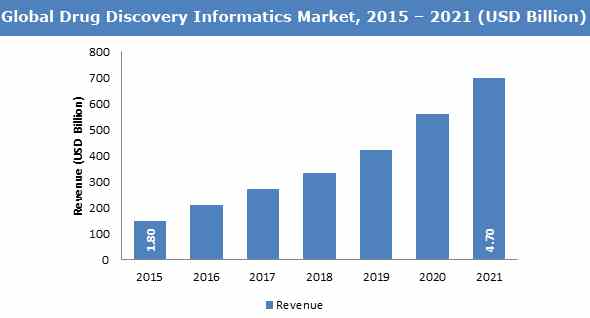
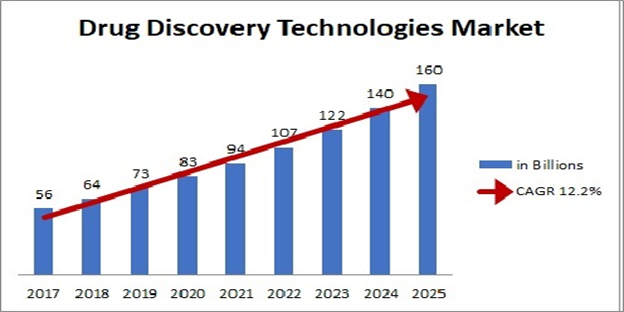
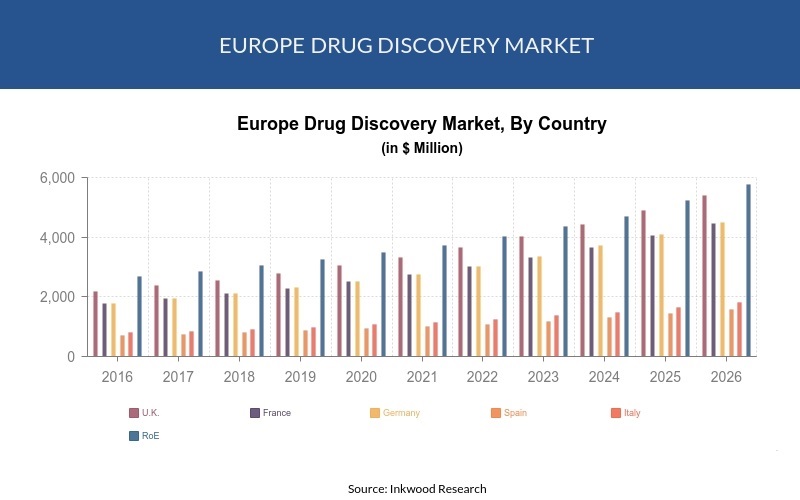
Conference Highlights
- Pharmaceutics and Biophamaceutics
- Medicinal chemistry
- Pharmacology
- Clinical Pharmacy
- Industrial Pharmacy
- Molecular Drug Designing
- Drug Discovery & Development
- Drug Delivery Systems & Devices
- Drug Targeting
- Phytopharmaceuticals / Phytotherapeutics
- Biotherapeutics
- Solid-state pharmaceutical chemistry
- Nanomedicine & Nanotechnology
- Pharamacognosy & phytochemistry
- Pharmacovigilence
- Pharmacogenetics & Pharmacogenomics
- Ethnomedicine & Ethnopharmacology
- Pharmacoepidemiology
To share your views and research, please click here to register for the Conference.
To Collaborate Scientific Professionals around the World
| Conference Date | November 25-26, 2019 | ||
| Sponsors & Exhibitors |
|
||
| Speaker Opportunity Closed | |||
| Poster Opportunity Closed | Click Here to View | ||
Useful Links
Special Issues
All accepted abstracts will be published in respective Our International Journals.
- Journal of Clinical Research and Pharmacy
- Journal of Pharmacy and Pharmaceutical Research
- International Journal of Clinical Skills
Abstracts will be provided with Digital Object Identifier by


